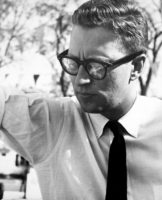New York City Mayor Bill de Blasio joined with community leaders in Harlem on a rainy Monday morning to celebrate an innovative housing development nearing completion in the neighborhood’s historic Sugar Hill enclave. Designed by David Adjaye, the 191,500-square-foot mixed-use development incorporates permanently affordable housing, pre-kindergarten classrooms, and the new Sugar Hill Children’s Museum of Art & Storytelling.
“It is so rare to see a city do this kind of project,” the London- and New York-based Adjaye explained at the press conference yesterday before leading a tour of the building. “It seems so obvious, but it is so lacking.” Built on a former brownfield site that most in the neighborhood had given up on, the towering new structure represents a unique community revitalization project that incorporates housing with educational and cultural facilities.
“This building is the epitome of everything we want to do with housing across the spectrum of incomes,” de Blasio said. As part of his ambitious goal of building and preserving 200,000 affordable housing units in the next decade, the Sugar Hill project also addresses another of the mayor’s passions—universal prekindergarten education for children throughout the five boroughs, a platform on which he ran in the November election and which was recently passed.
Occupying prime real estate in the new building, the ground floor early childhood education center will open in September for the new school year and serve up to 200 children from birth to age five. The completely glazed and slightly elevated classrooms offer stunning views of a nearby park and the surrounding community. Two protected courtyards within the 11,573-square-foot center offer outdoor space for the children.
The 17,600-square-foot museum, opening a little later in the year, is located in the basement, though large windows at the ground level entrance provide views into it from above. Adjaye also designed what he calls a “light chimney” along a corridor between galleries to bring daylight deep within the underground exhibition, storytelling, and art making spaces.
In August, tenants will begin to move into the building’s mix of studios, one-, two-, and three-bedroom apartments, spread out over 11 floors. More than 50,000 families and individuals applied for the 124 available units, which include 25 residences for the formerly homeless. Fifty apartments will be affordable for families earning below $41,500 for a family of four, and 12 will serve those earning less than $24,900 for a family of four.
The seventh affordable housing project developed by Broadway Housing Communities—a nonprofit community-based organization founded in 1983—Sugar Hill was financed by the New York City Department of Housing Preservation and Development, which dedicated $10 million in federal HOME funds and $3 million in tax credits, in addition to $3 million in capital funding from the City Council.
When asked what he hoped for in the design of such projects, de Blasio responded, “We try to do the most with the most lasting impact,” adding that he clearly wants buildings to be beautiful and contextually appropriate. In the design of this building, Adjaye was heavily influenced by “the great community, great legacy, and great architecture” of Sugar Hill, an area that evokes the Harlem Renaissance and whose elegant rowhouses were once home to the likes of W. E. B. Du Bois, Thurgood Marshall, Duke Ellington, and Cab Calloway.
Rising as it does atop Coogan's Bluff promontory, the massing of this project—with what appear as two immense boxes stacked slightly askew on top of each other—might be imposing for some. The too small—and in some cases from within the apartments, too high—windows don’t help to soften that effect. Adjaye looked to the setbacks of adjacent townhouses to create the jagged faces on parts of the façade in order, he says, to create variety and avoid a monolithic appearance. The dark, pre-cast concrete panels that clad the entire building are etched with abstracted images of roses, a famous symbol of Sugar Hill, at various scales, though close examination was required to recognize that intent on the wet façade the day of this visit.
Though obviously not perfect and constrained by budget, the building’s design intent and inspiring mixed-use program is a model for future affordable housing projects within New York City and around the country.













Post a comment to this article
Report Abusive Comment